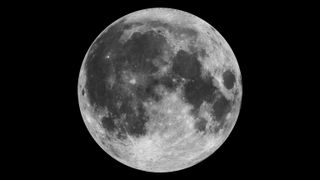
The moon, as seen by the United States' Clementine spacecraft in 1994.
(Image: © NASA)
A glimpse into China's readiness to handle samples from the moon reveals steps to be taken for storage, processing and preparation of the specimens.
China's Chang'e 5 robotic moon mission is scheduled to launch later this year. That venture represents the third phase of China's Chang'e lunar exploration program: returning samples from the moon.
The reported candidate landing region for Chang'e 5 is the Rümker region, located in the northern Oceanus Procellarum ("Ocean of Storms"). The area is geologically complex and known for its volcanic activity.
The Chang'e 5 mission has four main parts: an orbiter, ascender, lander and Earth reentry module, which will contain up to 4.4 lbs. (2 kilograms) of lunar surface and subsurface samples.

Sample history
The former Soviet Union successfully executed three robotic lunar sample return missions. Luna 16 returned a small sample (101 grams) from Mare Fecunditatis ("Sea of Fertility") in September of 1970; in February 1972, Luna 20 returned 55 grams of soil from the Apollonius highlands region; and Luna 24 retrieved 170.1 grams of lunar samples from the moon's Mare Crisium ("Sea of Crisis") for return to Earth in August 1976.
The United States brought back much more moon material. The six Apollo missions that touched down on the lunar surface from 1969 to 1972 collected 842 lbs. (382 kg) of lunar samples at different landing sites on the lunar surface, including rocks, core samples, lunar soil and dust.
China's moon rock plans
In a paper that was scheduled to be presented last month at the Lunar and Planetary Science Conference (LPSC), which ended up being cancelled due to concerns about the novel coronavirus, lead author G. L. Zhang from the National Astronomical Observatory, Chinese Academy of Sciences, details the main tasks of the Ground Research Application System (GRAS) of the country's lunar exploration project.

Δεν υπάρχουν σχόλια:
Δημοσίευση σχολίου